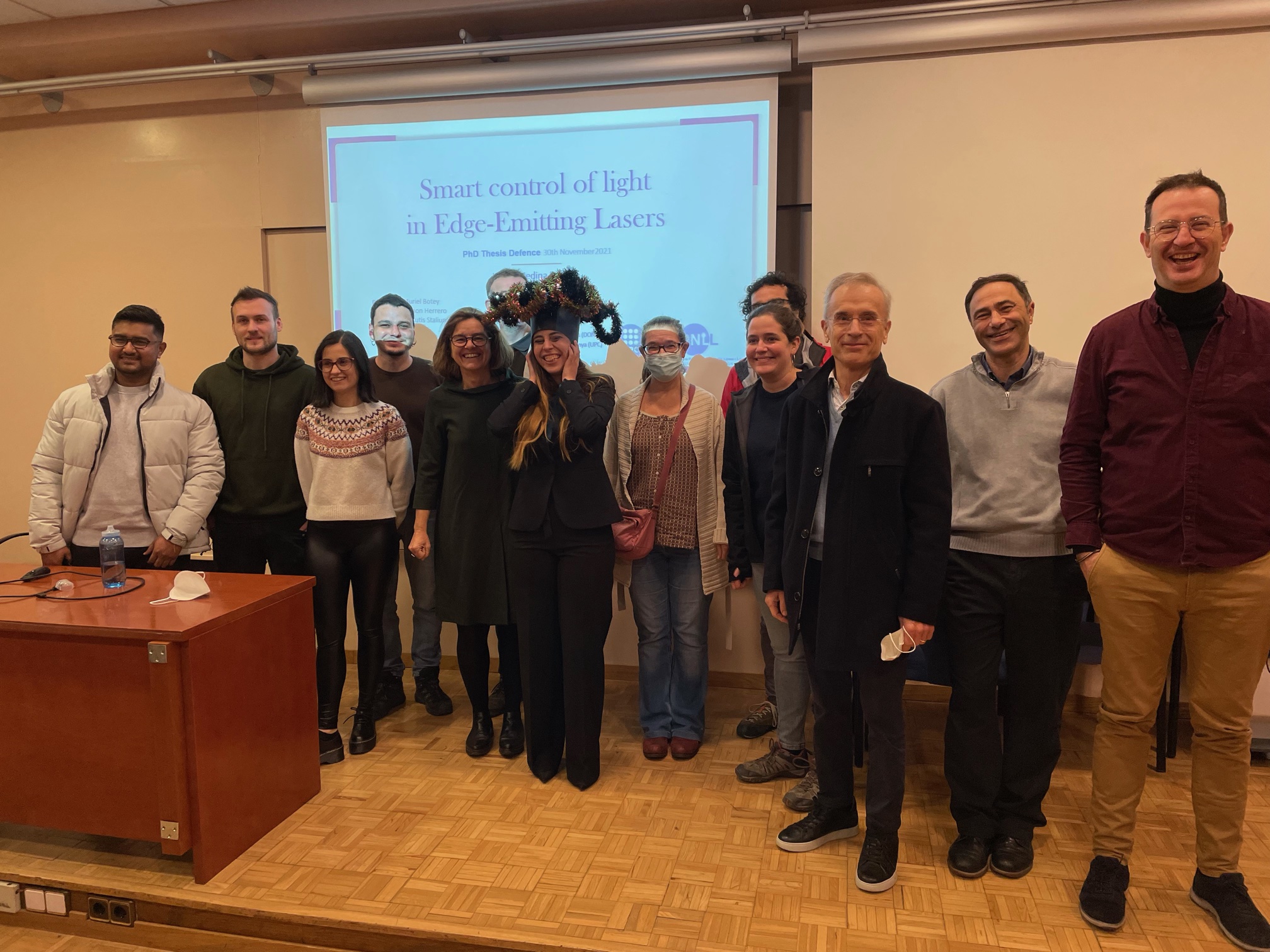Judith Medina defended her PhD thesis
Dec 01, 2021
Judith Medina Pardell defended her PhD thesis on "Smart control of light in edge-emitting lasers"
Congratulations Judith!
Title: Smart control of light in edge-emitting lasers
When: 30th november 2021, 10:30h
Where: ESEIAAT. UPC Campus. Terrassa
Supervisors: Muriel Botey (director) , Ramon Herrero (codirector) and Kestutis Staliunas (tutor).
Summary:
The invention of the laser triggered the study of light-matter interactions. In turn, the advent of artificial structured materials on micro- and nanometer scales has become a fruitful playground to tailor the propagation and generation of light, even in exotic or counterintuitive ways, uncovering novel physical phenomena. In this thesis, we precisely propose using recently discovered properties of artificial photonic materials, and new schemes, to control the spatiotemporal dynamics of broad area semiconductor lasers and improve their performance.
Semiconductor lasers are replacing other laser sources due to their efficiency, compactness and affordable prices, however suffering from a major drawback. The quality of the emitted beam intrinsically deteriorates when power increases, if the aperture of the laser is very broad as compared to wavelength. The highly multimode and unstable emission limits possible applications of these lasers. Although different mechanisms have been proposed to save this obstacle, obtaining a stable and bright emission remains a longstanding open question. This thesis aims at contributing to this goal without compromising their compact design, and to the new field of non-Hermitian Photonics providing new insights into the control of wave dynamics in artificial complex media. Indeed, the physics of open-dissipative, non-Hermitian systems offers new possibilities to utilize the gain and loss for steering optical processes, and is beyond the recent focus on non-Hermitian Photonics. As initially demonstrated in the frame of Quantum Mechanics, systems with gain and losses may still present real eigenvalues of the Hamiltonian (energy) as the purely conservative ones, yet holding other unexpected physical behaviors, derived from an asymmetric coupling between modes. In particular, this was first observed in systems invariant under parity (P-) and time (T-) symmetry ― referred as PT-symmetric ―. Optical systems with complex permittivity are flexible and achievable classical analogs of such quantum systems to realize and explore these effects.
As a first step, we propose to use a chirped modulation of the refractive index (chirped photonic crystal) for intracavity filtering the multimode emission of EELs. To numerically assess the filtering performance, we developed a full (2+1)-dimensional spatio-temporal model, including both transverse and longitudinal dimensions plus time, for the evolution of the electric field and carriers. The good agreement between predictions with actual experimental results demonstrates the proposal while validating the model which is used throughout the thesis, with corresponding modifications. We then analyze the effect of intrinsically imposing in phase refractive index and gain modulations within the semiconductor laser, and use the interplay between real and imaginary parts of the non-Hermitic potential to achieve spatial and temporal stabilization. Taking one step further, we propose to divide the EEL cavity into two mirror-symmetric half-spaces, both holding PT-symmetry but with opposite mode coupling. With this geometry, we expect to obtain a two-fold benefit: on the one hand, achieving a spatial-temporal stabilization of the laser, and on the other, localizing the generated field along the symmetry axis. We numerically demonstrate regimes of simultaneous localization and stabilization leading to an enhanced output and improved beam quality. Finally, while thinner lasers show a more stable new temporal and synchronization instabilities arise in EELS arrays (bars) from the coupling between neighboring lasers, leading again to irregular spatiotemporal behaviors. We show that the proposed mirror symmetric non-Hermitian configuration may be extended to couple individual EELs in the array, by a lateral shift between the pump and index profiles. In all cases, the obtained localized and stable output beam may facilitate a direct coupling of the emitted beam to optical fibers.

Share: